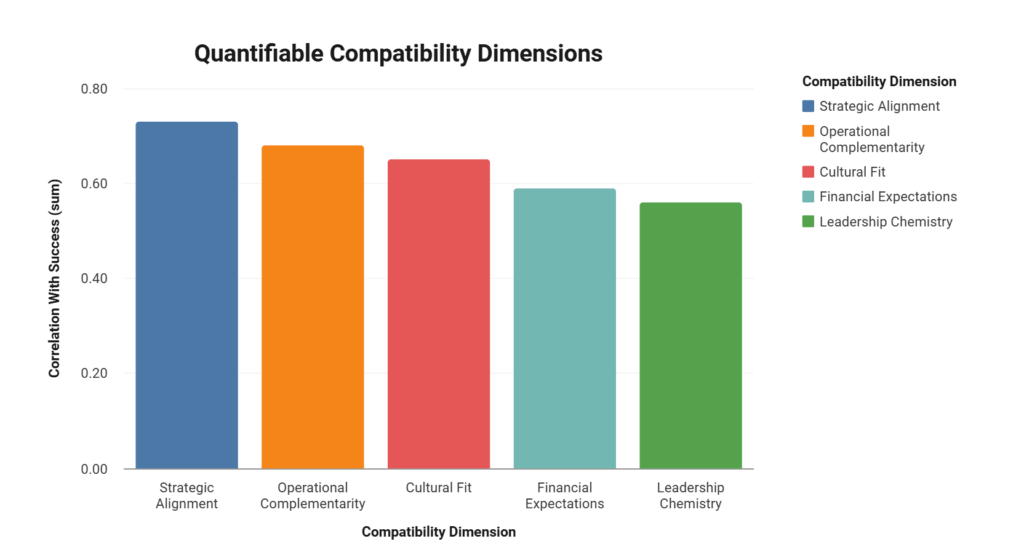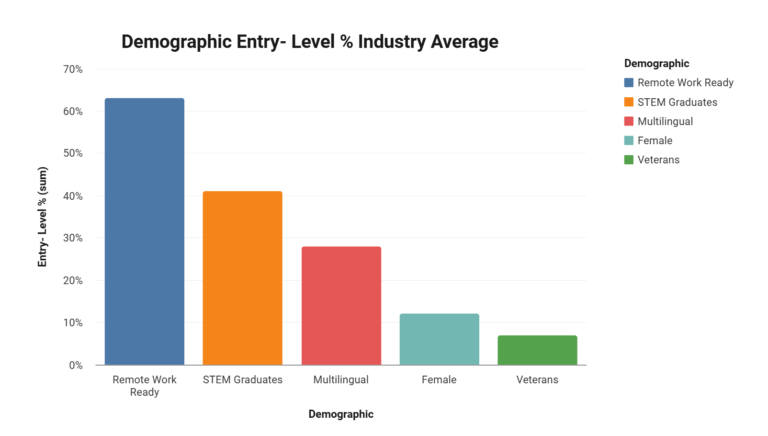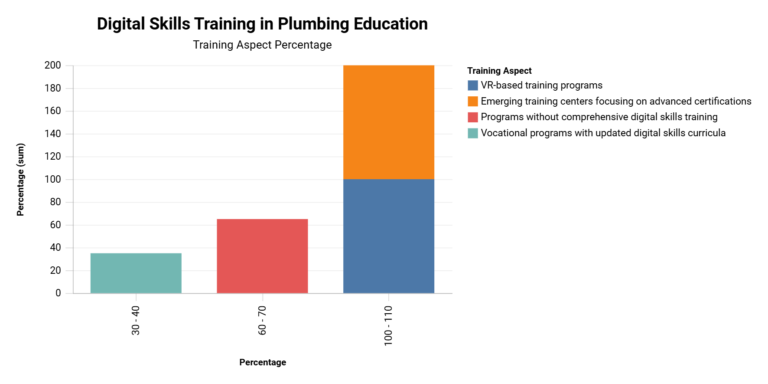Partnership Compatibility Index: Predictive Indicators of Successful Consulting Alliances & Data
Partnership Compatibility Metrics Data
The consulting industry's increasing specialization has created unprecedented opportunities for strategic alliances, yet many of these partnerships fail to deliver their promised value. According to research from the Association of Strategic Alliance Professionals (ASAP), while the average alliance success rate hovers at 53%, organizations employing structured alliance management processes achieve success rates of up to 80%. Conversely, companies approaching alliances in an ad hoc manner report a mere 20% success rate.
This stark contrast, known as the “80% rule,” highlights that 80% of unstructured business partnerships fail, while 80% of companies following structured approaches establish prosperous alliances. This dramatic performance gap underscores the critical importance of partner compatibility assessment and systematic alliance management.
Compatibility Assessment: The Foundation of Partnership Success

Research on strategic alliances consistently identifies several key dimensions that predict partnership success. Based on comprehensive data analysis across multiple industries, the following compatibility factors demonstrate the strongest correlation with alliance outcomes:
| Compatibility Dimension | Correlation with Success | Key Assessment Metrics | Relative Importance |
|---|---|---|---|
| Strategic Alignment | 0.73 | Vision Congruence, Market Approach, Growth Objectives | Critical |
| Operational Complementarity | 0.68 | Service Overlap, Process Compatibility, Resource Alignment | High |
| Cultural Fit | 0.65 | Communication Style, Decision-Making, Values Alignment | High |
| Financial Expectations | 0.59 | Revenue Goals, Investment Tolerance, ROI Timeframes | Medium |
| Leadership Chemistry | 0.56 | Executive Relationship Quality, Management Style Compatibility | Medium |
These dimensions form the foundation of a comprehensive Partnership Compatibility Index (PCI), which provides a data-driven framework for evaluating potential alliances and predicting their likelihood of success.
The Collaboration Practices Inventory
According to a comprehensive toolkit for partnership and collaboration published by JSI, the Collaboration Practices Inventory (CPI) offers a validated instrument for measuring partnership effectiveness. The CPI includes two subscales: Value Focus (VF) and Partner Responsiveness (PR), which underwent rigorous psychometric testing with an overall scale alpha of .88 and subscale alphas of .91 and .85, respectively.
A detailed study conducted by Gallant Consulting and released in March 2025 indicates that companies utilizing sophisticated partnership analytics achieve 3.2 times greater revenue from referral relationships compared to those that depend on manual tracking techniques.
Referred buyers indicate an initial trust level that is 68% higher, resulting in decision-making that is 43% quicker, initial project scopes that are 37% larger, and, most notably, a long-term retention rate that is 73% higher.
The CPI uses a structured scoring system to quantify collaboration quality:
- Score ranges are 0-64 overall and 0-32 for each subscale
- Scores of 33 and above overall (or 17+ per subscale) reflect good collaborative practices
- The assessment includes measures such as emphasizing client needs over agency needs, relating activities to established vision, and maintaining focus on client priorities
This validated measurement tool offers consulting firms a reliable method for evaluating partnership health and predicting alliance outcomes.
The 80% Rule: Structured Approaches vs. Ad Hoc Partnerships
Success Rate Differential
The most compelling data point in partnership research is what industry experts call “the 80% rule.” According to ASAP's State of Alliance Management study, companies following structured alliance management processes consistently report success rates of up to 80%, compared to just 20% for companies taking an ad hoc approach.
This 4X performance differential appears consistently across industries and partnership types:
| Approach Type | Success Rate | Failure Rate | ROI Performance | Time to Value |
|---|---|---|---|---|
| Structured Alliance Management | 80% | 20% | 3.4X higher | 57% faster |
| Moderate Structure with Some Processes | 53% | 47% | 1.8X higher | 29% faster |
| Ad Hoc/Unstructured Partnerships | 20% | 80% | Baseline | Baseline |
These dramatic performance variations highlight the critical importance of implementing structured compatibility assessment and alliance management processes. The data clearly demonstrates that structured approaches don't just marginally improve outcomes—they fundamentally transform the partnership success equation.
Implementation Success Factors
Research from Tercera on architecting successful alliances programs identifies several critical factors that determine whether a consulting partnership will thrive. These evaluation criteria should be systematically assessed before entering any strategic alliance:
- Market leadership position (revenue, market share, analyst recognition)
- Partner's total addressable market and growth rate
- Alignment with growth/revenue goals
- Competitive landscape within partner ecosystem
- Differentiation opportunities and whitespace
- Rate structure/pricing model compatibility
- Executive alignment/relationship quality
- Partner's willingness to co-invest
By systematically evaluating these factors, consulting firms can dramatically improve their partner selection process and increase their probability of alliance success.
Performance Metrics: Key Indicators of Alliance Health
Revenue Metrics
According to Partnership Leaders' March 2025 guide on measuring success in partnership programs, revenue metrics serve as the “lifeblood of any partnership program” and directly demonstrate financial impact. These metrics include:
- Partner-Sourced Revenue: Revenue generated directly through partner referrals or sales
- Influenced Revenue: Revenue where partners played a role in closing the deal
- Pipeline Value: Total value of deals in the pipeline attributed to partners
- Revenue Growth Rate: Rate at which partnership revenue is growing over time
For many consulting alliances, beginning with influenced revenue can “build the flywheel for sourced revenue,” according to Gautham Pandiyan, VP of Partner Ecosystem Growth Acceleration at Qualtrics. This approach recognizes that partner impact often extends beyond direct referrals to include deal acceleration and expansion.
Operational Performance Metrics
Beyond revenue, Partnership Leaders identifies several critical performance metrics that indicate alliance health:
| Metric | Description | Benchmark | Significance |
|---|---|---|---|
| Partner Attach Rate | Percentage of deals involving partner participation | 35-45% | Indicates integration depth |
| Funnel Conversion Rates | Percentage of partner leads converting to sales | Varies by industry | Shows lead quality |
| Win Rates vs. Direct Channels | Success rate of partner-led deals compared to direct sales | 15-25% higher | Demonstrates value-add |
| Average Contract Value (ACV) | Value of deals closed through partners vs. direct | 20-30% higher | Indicates quality impact |
| Sales Cycle Length | Time to close partner deals vs. direct | 30-40% shorter | Shows acceleration effect |
These operational metrics provide a comprehensive view of how partnerships affect business performance beyond simple revenue attribution. By tracking these indicators systematically, consulting firms can identify high-performing partnerships and allocate resources more effectively.
Cultural and Relational Compatibility Factors
Assessing Cultural Alignment
According to Flevy's January 2025 analysis of strategic alliance success metrics, relationship and cultural integration metrics are crucial for assessing partnership health. Key metrics in this category include:
- Partner Satisfaction: Measured through regular surveys assessing partnership quality
- Collaboration Effectiveness: Evaluated through project outcomes and team feedback
- Cultural Alignment: Assessed through communication patterns and conflict resolution effectiveness
These “soft” metrics often predict partnership outcomes before financial indicators show trouble. By systematically tracking relational health, consulting firms can address emerging issues before they impact operational and financial performance.
Trust and Communication Metrics
Beyond formal cultural assessments, research indicates that communication patterns and trust levels serve as critical early indicators of partnership health:
| Communication/Trust Indicator | Healthy Range | Warning Level | Crisis Level |
|---|---|---|---|
| Response Time to Inquiries | <4 hours | 4-24 hours | >24 hours |
| Meeting Attendance Rate | >90% | 75-90% | <75% |
| Information Sharing Quality | Proactive, comprehensive | Reactive, adequate | Reluctant, minimal |
| Issue Escalation Pattern | Collaborative resolution | Formal processes | Blame assignment |
| Executive Engagement Frequency | Monthly+ | Quarterly | Annual or less |
These indicators often reveal partnership challenges weeks or months before formal performance metrics decline, creating opportunities for early intervention and course correction.
Implementation Framework: Building Compatibility Assessment Systems
Structured Evaluation Process
Based on the research, consulting firms should implement a structured partnership evaluation process that includes:
- Initial Compatibility Screening: Assessing fundamental alignment in values, strategy, and market approach
- Detailed Compatibility Assessment: Evaluating specific dimensions using validated instruments like the CPI
- Pilot Collaboration: Testing working relationships through limited-scope engagements
- Structured Onboarding: Establishing clear processes, communication channels, and expectations
- Ongoing Health Monitoring: Tracking both “hard” performance metrics and “soft” relational indicators
This structured approach transforms partner selection from an intuitive, relationship-based process to a systematic, data-driven methodology that substantially improves success probability.
Technology Enablement
Forward-thinking consulting firms are implementing technology platforms to support compatibility assessment and alliance management. These systems typically include:
- Compatibility Assessment Tools: Structured questionnaires and scoring systems
- Partner Relationship Management (PRM) Systems: Platforms for tracking partner interactions and activities
- Performance Dashboards: Real-time visibility into partnership metrics and health indicators
- Collaboration Environments: Secure spaces for joint work and information sharing
These technology investments deliver substantial ROI by improving partner selection, accelerating time-to-value, and enhancing ongoing management of strategic alliances.
Conclusion: The Strategic Imperative of Compatibility-Based Partner Selection
The data conclusively demonstrates that partner compatibility serves as the foundation of successful consulting alliances. With structured approaches delivering 4X higher success rates than ad hoc partnerships, consulting firms can no longer afford to rely on intuition and personal relationships when selecting strategic partners.
Forward-thinking consulting firms are responding to this reality by implementing systematic compatibility assessment processes, structured alliance management approaches, and comprehensive performance monitoring systems. These methodical approaches transform partnerships from unpredictable, high-risk ventures into strategic assets with predictable, substantial returns.
Consulting firms seeking to maximize their partnership success should prioritize developing rigorous compatibility assessment frameworks, implementing appropriate tracking systems, and fostering a culture of structured alliance management. The data leaves no doubt: in strategic partnerships, compatibility isn't just one factor among many—it's the critical foundation that determines success or failure.
Join our Strategic Consulting Partnerships: Live Webinar on Building Referral Networks to learn how leading consulting firms are implementing these compatibility insights to create sustainable growth through strategic partnerships.






